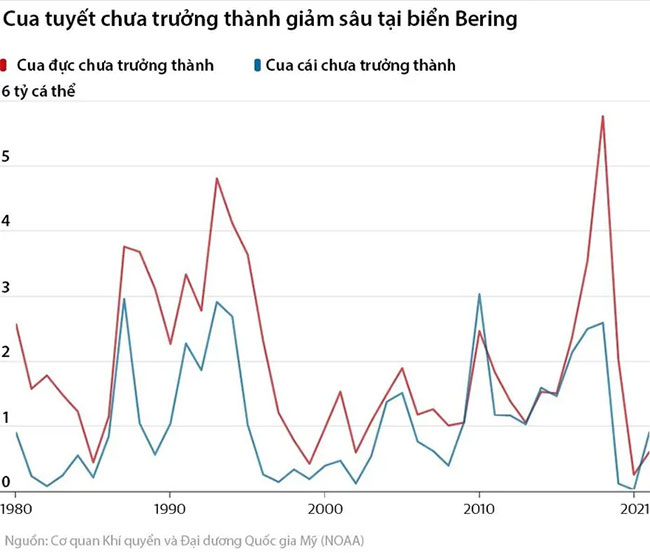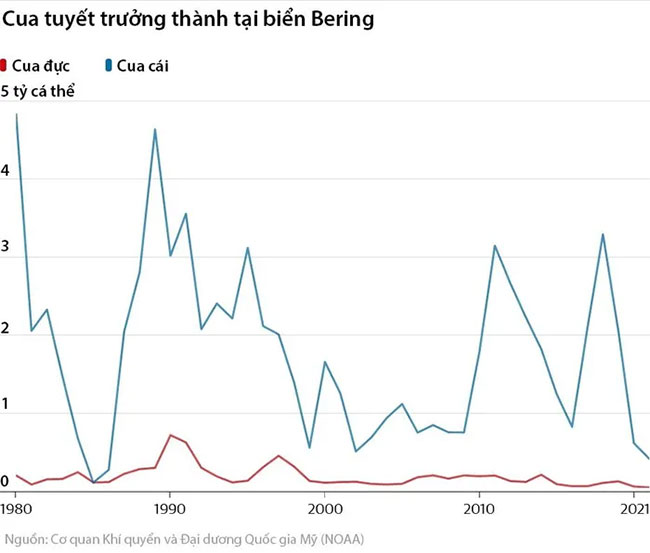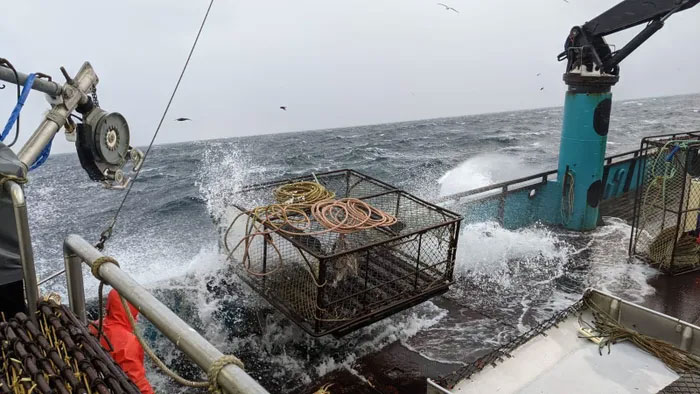The reasons behind the decline of the Alaskan snow crab population from an estimated 11 billion to just 2 billion in just four years are still being clarified by scientists.
The sight of snow crabs bustling in the Bering Sea off the coast of Alaska (USA) has become all too familiar to observers. This species has helped build a $160 million per year industry in Alaska.

Snow crabs being sorted at Mikuni Fish Market in Fukui Prefecture, Japan. (Photo: Bloomberg).
However, this year, U.S. federal seafood management officials had to cancel the Alaskan snow crab season for the first time, according to the Washington Post. The reason is that the population of this species has decreased by more than 80% since 2018.
In addition to the unforeseen ecological consequences of the population decline, the cancellation of the snow crab season has left fishermen who rely on this industry anxious.
Nevertheless, Alaska officials assert that they had no choice due to the dire situation of the snow crab. They “must balance the impacts (on the fishing industry and community) with the need for long-term conservation and sustainability of crab stocks,” according to the New York Times.
Scientists are urgently investigating the possible causes behind this decline, with many hypotheses proposed. Among these, climate change is considered the most suspicious culprit.
Origins of the Crisis
The first point to clarify is that this is not a sudden decline, Erin Fedewa, a marine biologist with the National Oceanic and Atmospheric Administration (NOAA), told the Guardian.
“The story of the snow crab must begin in 2018,” Fedewa said.
2018 recorded an unusually high number of snow crabs, coinciding with one of the hottest years ever recorded in the Bering Sea. This year also saw several periods of sea ice levels in the Bering Sea falling to record lows.

The number of juvenile snow crabs in the Bering Sea has plummeted. (Graphic: Guardian).
In 2019, which also recorded record temperatures, NOAA’s annual survey in the eastern Bering Sea showed that the number of juvenile snow crabs had significantly declined.
Researchers believe that warming seawater has made it more difficult for juvenile snow crabs because they typically thrive in the cold waters at the sea floor. These cold waters maintain low temperatures thanks to melting sea ice.
It is likely that the rapid melting of sea ice, combined with warming seawater, has pushed temperatures in these cold waters above the 2 degrees Celsius threshold necessary for juvenile snow crabs to develop, causing their habitat to shrink.
By 2021, NOAA’s survey showed that not only juveniles but snow crabs at all developmental stages had decreased in number, Fedewa said.
“I remember standing on the boat, and I noticed something was unusual. At some stations where we used to collect samples of several thousand crabs, we could only catch maybe a few hundred,” Fedewa recounted.

Not only juvenile snow crabs, but adult snow crabs are also declining. (Graphic: Guardian).
This situation continued into 2022, when surveys showed that the snow crab population had dropped to 1.9 billion individuals, compared to an estimated 11.7 billion individuals in 2018.
The decline in snow crab numbers also means that predators lose a food source. This food source will need to be supplemented from elsewhere in the ecosystem, said Darrel Mullowney, a snow crab scientist at Fisheries and Oceans Canada.
Habitat Shrinking
One hypothesis suggests that the shrinking cold-water environment at the bottom of the eastern Bering Sea has made snow crabs more vulnerable to predators.
This hypothesis posits that previously, the icy waters suitable for snow crabs created a buffer zone that prevented less cold-tolerant crab predators, such as Pacific cod, from accessing snow crab territory. However, as the Bering Sea warms, this fish may be able to reach snow crab habitats.
However, this hypothesis cannot be entirely accurate, Fedewa noted, as Pacific cod cannot eat larger adult crabs. Therefore, this hypothesis does not fully explain the widespread population decline of snow crabs.
Another hypothesis is that habitat shrinkage has forced snow crabs into more crowded living environments, thereby accelerating the spread of infectious diseases.
All of the above hypotheses are currently being investigated by NOAA researchers, Fedewa said. But they all share a common point, which is the warming of seawater.
“All these mechanisms can be explained by the significant temperature changes we witnessed in 2018 and 2019,” Fedewa stated.

Scientists believe climate change is the cause of the snow crab’s disappearance. (Photo: Gabriel Prout).
Impact of Fishing
Some speculate that fishing activities may have also contributed to the decline in snow crab numbers.
Snow crab fishermen have expressed concerns, particularly about commercial bottom trawlers that often use bottom-dragging nets, catching all marine life in their path.
Additionally, as commercially valuable species like Pacific cod are moving to warmer northern waters, there are concerns that fishing vessels will follow and catch non-target species, such as snow crabs.
“Any fishing industry experiences bycatch. In spring, when snow crabs molt, they are very vulnerable when exposed to boats,” Fedewa said.
More research is needed to understand the impact of fishing on the decline of snow crabs. Fedewa also believes that multiple causes have combined to lead to this phenomenon.
“Through the story of the Bering Sea, we can draw lessons about the interconnectedness of the entire ecosystem. It is very rare for a single process to be the sole cause behind a phenomenon,” Fedewa remarked.


















































